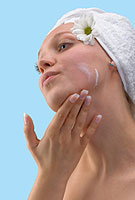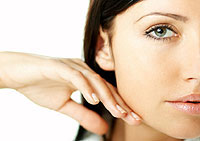| |
Allergic Dermatitis
A rash is a change in the skin’s color or texture. Simple rashes are called dermatitis, which means the skin is inflamed or swollen. Some rashes can be due to an allergic reaction to medication or side effects from chemotherapy or something the skin is coming in contact with.
A dermatologist is usually able to determine the type of rash by looking at it and asking about accompanying symptoms. Sometimes lab test or a skin biopsy may be necessary to confirm the diagnosis. Mild rashes can often be treated with simple home care practices such as avoiding soaps and bathing in warm water. Others may require moisturizing creams, prescription medications or more extensive oral treatment.
Acne
 Acne is the term for the blocked pores (blackheads and whiteheads), pimples, and deeper cysts and nodules that can appear typically on the face, neck, chest, back, shoulders and upper arms. Seventeen million Americans currently have acne, making it the most common skin disease in the United States. While it affects mostly teenagers, adults of any age can have it. Acne can be the source of great emotional stress and may lead to physical and emotional scarring if not treated promptly and appropriately. The good news is nobody has to have acne because so many treatment options are available. Over the counter preparations can be helpful, but if clearance is not achieved within several weeks, prescription medication may be required. Dr. Berke specializes in creating a personalized program for each patient, from topical to oral medications. Dr. Berke is registered with the iPLEDGE program to dispense isotretinoin commonly known as Accutane®. Acne is the term for the blocked pores (blackheads and whiteheads), pimples, and deeper cysts and nodules that can appear typically on the face, neck, chest, back, shoulders and upper arms. Seventeen million Americans currently have acne, making it the most common skin disease in the United States. While it affects mostly teenagers, adults of any age can have it. Acne can be the source of great emotional stress and may lead to physical and emotional scarring if not treated promptly and appropriately. The good news is nobody has to have acne because so many treatment options are available. Over the counter preparations can be helpful, but if clearance is not achieved within several weeks, prescription medication may be required. Dr. Berke specializes in creating a personalized program for each patient, from topical to oral medications. Dr. Berke is registered with the iPLEDGE program to dispense isotretinoin commonly known as Accutane®.
For those patients who already have acne scarring, treatment may include certain skin care products, chemical peels, soft tissue fillers, and dermabrasion.
Rosacea

Rosacea is a chronic skin disease that causes pimples and redness on the face. The face, chest, and/or eyes may also be affected. Symptoms range from red pimples, lines and visible blood vessels to dry or burning skin and a tendency to flush easily. Many people find that the emotional effects of rosacea, such as low self-confidence and avoidance of social situations, are more difficult to handle than the physical ones. Although it can affect anyone, rosacea typically appears in light-skinned, light-haired adults aged 30 to 50. It is not known what causes rosacea and the disease is not curable, although it can be treated with topical and oral medications, or laser therapy.
Psoriasis
Psoriasis is a group of chronic skin disorders that cause itching and/or burning, scaling and crusting of the skin. Over seven million men and women in the U.S. of all ages have some form of psoriasis, which may be mild, moderate or severe. The most commonly affected areas are the scalp, elbows, knees, hands, feet and genitals.
Psoriasis cannot be cured but it can be treated successfully, sometimes for months or years at a time and occasionally even permanently. Treatment depends on the type, severity and location of psoriasis; the patient’s age, medical history and lifestyle; and the effect the disease has on the patient’s general and mental health. The most common treatments are topical medications, phototherapy, and oral or injectable medication.
Pregnancy Rashes
Various rashes can occur and are exclusive to pregnant woman. Although these rashes can be very uncomfortable, most often they are harmless and cause no harm to the unborn baby. It is important to be seen promptly and treated appropriately. There are treatments that can be administered that are safe during pregnancy. Dr. Berke will work with your Obstetrician to ensure that you are treated safely.
Alopecia
Hair loss can occur throughout the scalp or in small circular patches. Hair loss is a condition experienced by both men and women. It can be caused by a combination of aging, a change in hormones and a family history. Stress or an autoimmune process may also trigger Alopecia. It is best to have a thorough evaluation which may include blood work and a biopsy, prior to starting the appropriate treatment.
Fungal infections of skin, hair, and nails
Fungal infections of the skin are caused by microscopic organisms that live on the hair, nails (onychomycosis), mouth (angular cheilitis/oral thrush) and outer skin layers. They are quite common; the fungal infection cutaneous candidiasis, for example, which occurs in warm, moist crevices of the body, is the usual cause of diaper rash and vaginal yeast infections. Fungal infections are most likely to occur in people with diabetes, who are obese, or who take antibiotics or oral contraceptives. Treatments include topical and systemic antifungal medications.
Seborrheic Dermatitis (Dandruff)
 Seborrhea is a chronic skin condition of unknown origin which causes oiliness, scaling and redness of the skin, most often on the scalp (oftenly referred to as dandruff), ears, and face. Symptoms include scaly or flaky patches overlying red skin. Seborrhea and dandruff is multi-factorial, with over-colonization of yeast and excess oiliness being the main contributing factors. Although the skin behaves like it is dry, moisturizing does not help. Professionally recommended treatments such as cortisone creams and lotions and reduction of yeast on the skin surface, in combination with frequent gentle washing with the right shampoo, can alleviate symptoms. Dr. Berke and Guthy-Renker (the makers of Proactiv) have developed a treatment trio including a shampoo, conditioner, and anti-itch spray that helps clear scalp flaking and itching while still leaving the hair feeling, smelling and looking great. Seborrhea is a chronic skin condition of unknown origin which causes oiliness, scaling and redness of the skin, most often on the scalp (oftenly referred to as dandruff), ears, and face. Symptoms include scaly or flaky patches overlying red skin. Seborrhea and dandruff is multi-factorial, with over-colonization of yeast and excess oiliness being the main contributing factors. Although the skin behaves like it is dry, moisturizing does not help. Professionally recommended treatments such as cortisone creams and lotions and reduction of yeast on the skin surface, in combination with frequent gentle washing with the right shampoo, can alleviate symptoms. Dr. Berke and Guthy-Renker (the makers of Proactiv) have developed a treatment trio including a shampoo, conditioner, and anti-itch spray that helps clear scalp flaking and itching while still leaving the hair feeling, smelling and looking great.
|
|